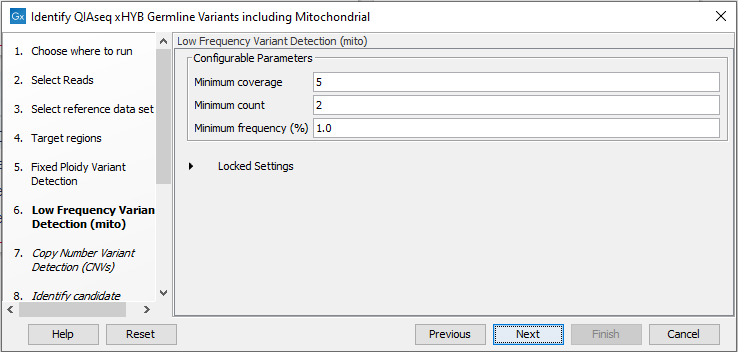Identify QIAseq Hybrid Capture DNA Germline Variants including Mitochondrial (Illumina)
The Identify QIAseq Hybrid Capture DNA Germline Variants including Mitochondrial (Illumina) template workflow is designed to call germline variants from data generated with e.g. QIAseq Multimodal DNA Library kit without UMIs or QIAseq FX DNA Library kit followed by hybrid capture-based target enrichment with addition of mitochondrial spike-in probes, such as QIAseq Exome, QIAseq xHYB Human, or panels from a third party provider. For panels from a third party provider, the same approach as described in QIAseq custom panels is recommended.
The workflow calls germline variants in the panel's target regions, as described in Identify QIAseq Hybrid Capture DNA Germline Variants (Illumina), and in target regions associated with a mitochondrial spike-in.
It can be found at:
Template Workflows | Biomedical Workflows (![]() ) | QIAseq Sample Analysis (
) | QIAseq Sample Analysis (![]() ) | QIAseq DNA workflows (
) | QIAseq DNA workflows (![]() ) | Identify QIAseq Hybrid Capture DNA Germline Variants including Mitochondrial (Illumina) (
) | Identify QIAseq Hybrid Capture DNA Germline Variants including Mitochondrial (Illumina) (![]() )
)
Mitochondrial variant calling is performed using the Low Frequency Variant Detection tool. The parameters for this can be set in the relevant wizard step when launching the workflow (figure 12.34). For a description of the different parameters that can be adjusted, see https://resources.qiagenbioinformatics.com/manuals/clcgenomicsworkbench/current/index.php?manual=Low_Frequency_Variant_Detection.html. If you click on "Locked Settings", you will be able to see all parameters used for variant detection in the template workflow. Resulting variants are filtered using a different filtering cascade compared to variants obtained from the Fixed Ploidy Variant Detection tool. The settings of the filtering cascade are locked by default.

Figure 12.34: Specify the parameters for the Low Frequency Variant Detection tool.
Please note that copy number variation analysis is restricted to the panel's target regions and will therefore not be performed for mitochondrial target regions.
The following output files are created separately for mitochondrial data:
- A Coverage report (
 ) and a Per region coverage track (
) and a Per region coverage track ( ) from the QC for Target Sequencing tool (see https://resources.qiagenbioinformatics.com/manuals/clcgenomicsworkbench/current/index.php?manual=QC_Targeted_Sequencing.html.
) from the QC for Target Sequencing tool (see https://resources.qiagenbioinformatics.com/manuals/clcgenomicsworkbench/current/index.php?manual=QC_Targeted_Sequencing.html.
- Three variant tracks (
 ): Two from the Low Frequency Variant Detection tool: the Unfiltered Variants is output before the filtering steps, the Annotated variants contains the variants after filtering and is the one used in the Genome Browser View (see https://resources.qiagenbioinformatics.com/manuals/clcgenomicsworkbench/current/index.php?manual=_annotated_variant_table.html for a definition of the variant table content). The third is the Indels indirect evidence track produced by the Structural Variant Caller. This is also available in the Genome Browser View.
): Two from the Low Frequency Variant Detection tool: the Unfiltered Variants is output before the filtering steps, the Annotated variants contains the variants after filtering and is the one used in the Genome Browser View (see https://resources.qiagenbioinformatics.com/manuals/clcgenomicsworkbench/current/index.php?manual=_annotated_variant_table.html for a definition of the variant table content). The third is the Indels indirect evidence track produced by the Structural Variant Caller. This is also available in the Genome Browser View.
- An Amino acid track (
 ) generated using the mitochondrial genetic code.
) generated using the mitochondrial genetic code.
Launching using the QIAseq Panel Analysis Assistant
The workflow is also available in the QIAseq Panel Analysis Assistant under Human Exome and xHYB Human.
